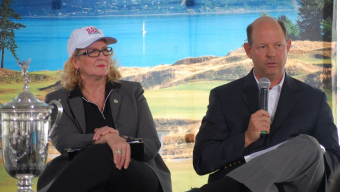UNIVERSITY PLACE, Wash. – The professional golfers who play the most practice rounds at Chambers Bay during the next 11 months could get a leg up on the remainder of the field heading into the 115th U.S. Open next summer.
“You are not going to know (Chambers Bay) in one or two rounds,” USGA executive director Mike Davis said Friday. “You have to have vision and imagination. I think the prudent player will come out early and try to learn the golf course.”
Davis was among a list of guest speakers who updated the local media on preparations for the first U.S. Open ever played in the Northwest. Everyone agreed that everything is going smoothly.
“We are basically 50 weeks away from the U.S. Open and we could not be positioned any better,” Davis said. “At this point, whether it’s Pinehurst, Chambers Bay, Merion, Shinnecock Hills, or Pebble Beach, we are now focusing on what we should be focusing on in terms of what happens inside the ropes, and that is the grass.”
For the first time in history, the U.S. Open will be played on 100 percent fescue grass.
“This is a very different golf course,” Davis said. “We have never played a National Open on fine fescue. This is a first. It feels like a British Open, but even British Opens do not have all fine fescue putting greens. The vast majority of the golfers will not have played on fine fescue greens. It has a much different look to it. When you watch a putt, it doesn’t bounce. Firm, but they roll beautifully.”
All eyes will be on the weather during the winter months, hoping that Mother Nature is kind and the fescue enters the warmer spring weather healthy.
“We want to make sure it’s as healthy as it can be,” Davis added.
As it is, the fescue greens will give the players a completely different putting surface than they are accustomed.
“Coming into any championship, there’s always that element of the unknown,” Davis said. “Fescue greens will be unique. I think the vast majority of players will embrace them, assuming we get them in the right condition. They should love it.”
At the same time, he knows some players are bound to complain.
“I’ve been a part of 25 U.S. Opens and read the history going back to 1895 and one thing I can say almost without fail — the players that embrace the setup and the architecture are the ones that have success,” Davis said. “The players that come in and complain about things, they don’t play well.
“You hear the stories about how Jack Nicklaus loved it when he started hearing complaints about the setup of a U.S. Open course. He would say, ‘OK, that person’s gone, that person I don’t have to worry about,’ and so on.”
But as far as the USGA and Pierce County is concerned, every glass in the building on Friday was half full.
“I think it’s going to be fascinating,” Davis said of the tournament. “The golfers are going to see things here they have never seen before at a U.S. Open. It’s going to be fun to watch.”
And there will be a lot of people watching.
The way tickets have been selling, a 29th consecutive sellout is basically in the books. Almost all tickets for two of the days have been purchased. Crowds will be limited to 30,000 for each day and there will be 20,000 bleacher seats.
What people will see is the first time two holes — 1 and 18 –will be played as either a par 4 or par 5 on alternating days and all four rounds are expected to be par 70. The lengths, ranging from 7,200 yards to 7,600 yards, will be determined each day by the USGA staff, taking into account the weather and course conditions.
Spectator areas will be available on the edges of the course and according to USGA’s Danny Sink, many of the views will allow spectators to see tee shots, fairway shots and even some greens from one location.
“We still have much work to do over the next 11 months regarding transportation, security, site planning and more,” Pierce County Executive Pat McCarthy said, “but we’re thrilled with the way this is coming together. We are extremely excited.”





















